Taxidermy4Cash.com
Taxidermy and the effort involved in creating a case.
We are always very interested in Purchasing Victorian Taxidermy, please respond via this on-line form of what you have for sale. HERE
We get asked to recommend Bird Taxidermists in the UK and America. This taxidermist produces modern creations utlising many of the design features and case building techniques created by the Victorian Taxidermists. This taxidermy art form has changed little over the years. Preservation techniques in terms of the use of chemicals has changed and groundwork has become more realistic. Apart from that the taxidermy techniques used 150 years ago are still relevant today.
We have always been interested in creating dioramas, with nest eggs and chicks and to also closely match the birds that associate together and also near as possible the habitat in which they would be likely to be found.
The case that is outlined below demonstrates the stages involved the choice of landscape, colours, materials and of course the choice of mounts. The ducks and goose we have chosen are two Harlequin ducks and a male dark phase Brent Goose, all North American but also all infrequent visitors to the UK.
The taxidermy has been undertaken by a world class taxidermist, with birds that have been legally obtained. To date some 100 plus hours have gone into the creation of the case. Three people have been involved also in the creation of the case and the anticpated total hours to creat may exceed 200. That said it matters not how long it will take to create this case as it shall never be for sale. Some interesting facts about the creation of this case. The styrafoam rockwork to 15-20 coats of paint to create both texture and depth. The resin required 6-10 applications for the same reason, allowing each application to dry prior to the next coat. Each stone is hand painted and then varnished to create a wet look. The birds, well taxidermists will know what they take to create, then of course there is the cabinet work and galzing. Clearly some people spend more time on cases and mounts than others.
The concept
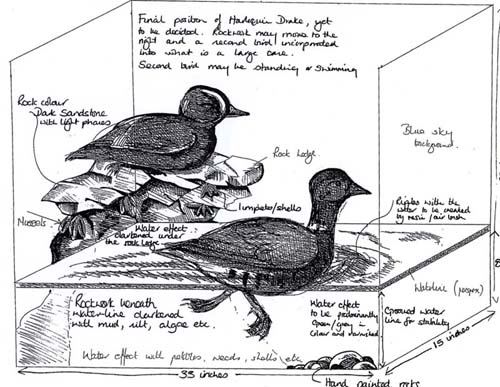
First we started with the above image and decided that the placement of the birds was wrong. That said we decided that the goose swimming made sense.
The completed case
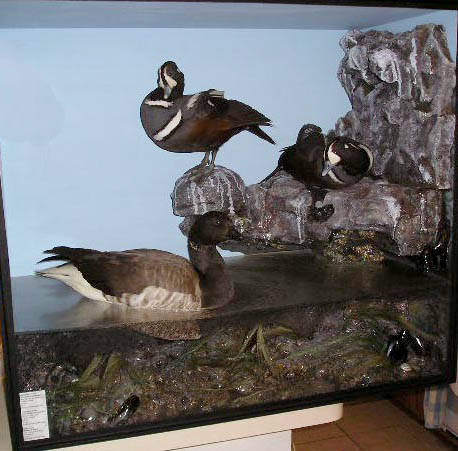
This case is completed, glazed and data. No Cornish influence in this design thankfully.
The nearly completed case, what you see here is over 100 hours of work.
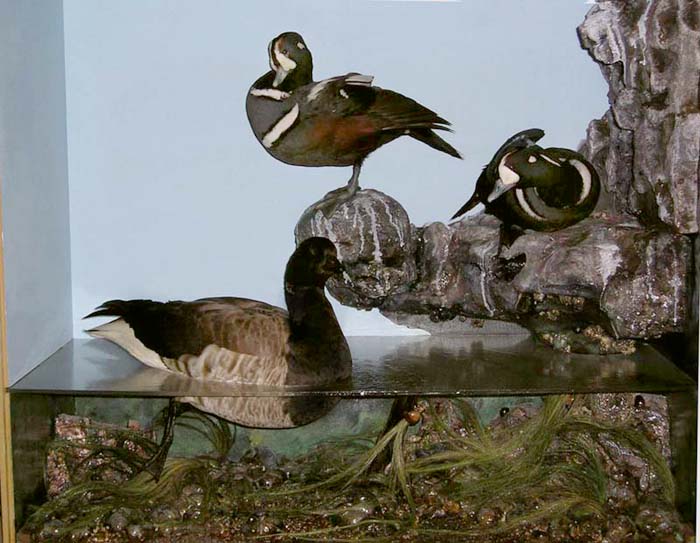
This case is nearly completed, just some beak painting and waxing and eel grass in the groundwork and the case is ready to be fumigated and glazed. Just one comment if you are considering completing cases with a water efect as above, make sure that you understand how to use resins ( I do not for the record!!). For example, We used two types. One that takes FOREVER to set (48 hours)and the other that sets almost straight from the mixing tub (seconds). Imagine the fun!!!!!!!!!!, given that all the birds had to be in the scene to work the resin into the scheme. You might not be able to see it but resin covers the rocks in places, beneath the large rock on the right and completely over the plexiglass. Paint effects may be used in the future.
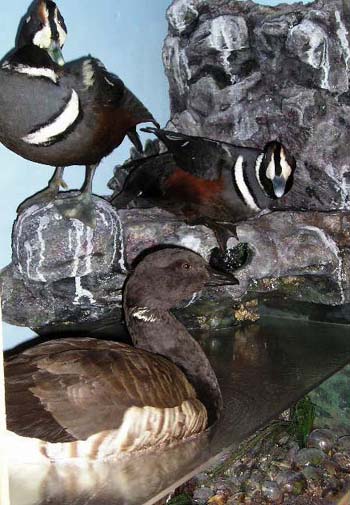
This case is nearly completed, just some beak painting and waxing and eel grass in the groundwork and the case is ready to be fumigated and glazed.
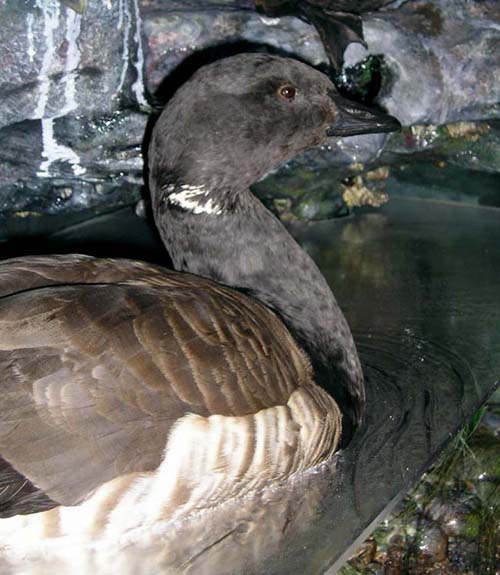
This case is nearly completed, just some beak painting and waxing and eel grass in the groundwork and the case is ready to be fumigated and glazed. Not too sure about the water effect at the front of the bird. Added some paint to darken and it looks wrong. Hey that said, far better an effort than most commerical taxidermist's we have seen. Yup you know who you are.
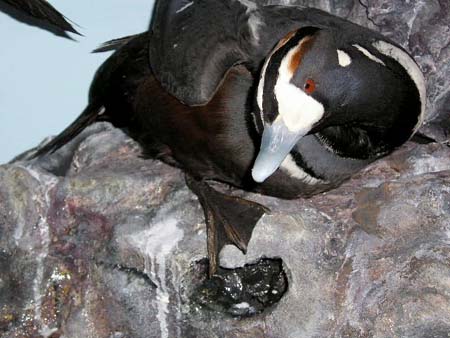
This case is nearly completed, just some beak painting and waxing and eel grass in the groundwork and the case is ready to be fumigated and glazed.
Part of the process in stages
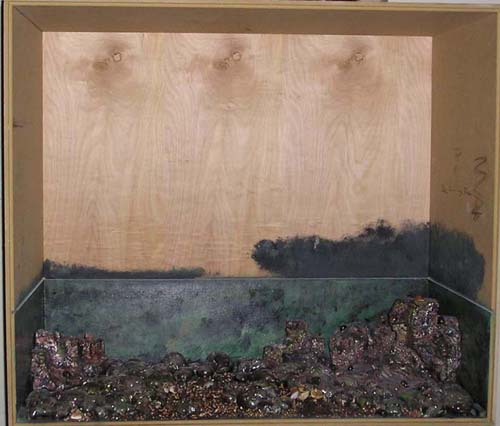
First was started with a flat fronted box type construction. The dimensions of the case are as follows. Length 35 inches, height 29 inches and depth 16 inches. The perspex chosen will also be airbrushed and resin added to create movement in the water.
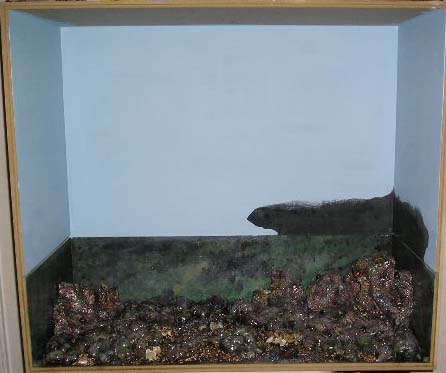
Groundwrok created first and the background painted blue to get a general effect of scale and dimension(s).
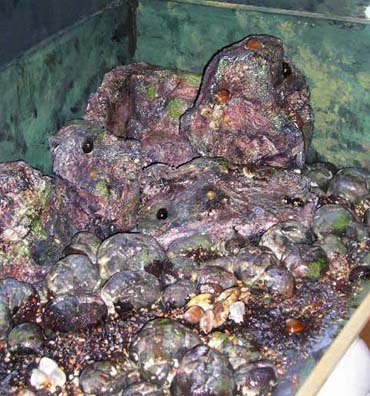
The rocks, small and large were created using styrafoam and plaster of paris and then hand painted and sprayed with varnish to create a wet look.
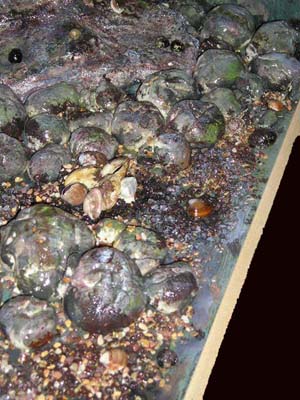
Close up image of the above.
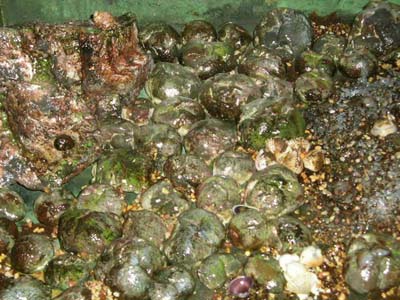
The above in close up.
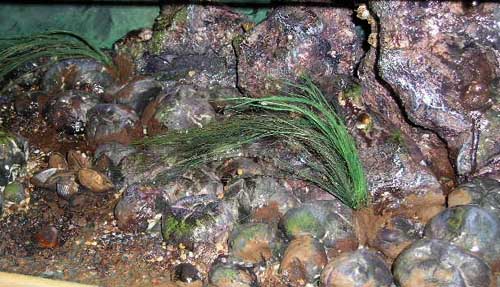
Horse hair (mane) has been dyed green and then glued into place. This is better to use than grass as it allows flexibility and gives the sense of movement.
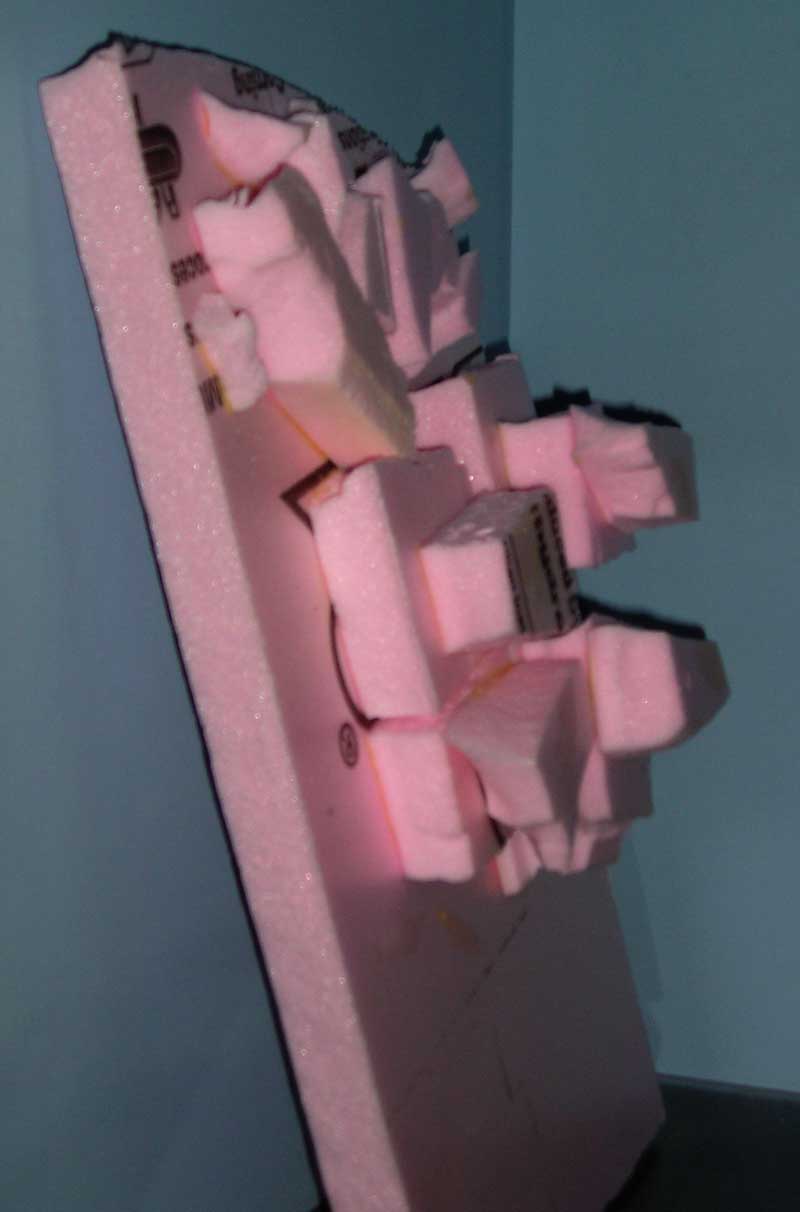
Rocks start out as expanded foam, glued to create a 3D effect and then covered in plaster of paris and allowed to dry.
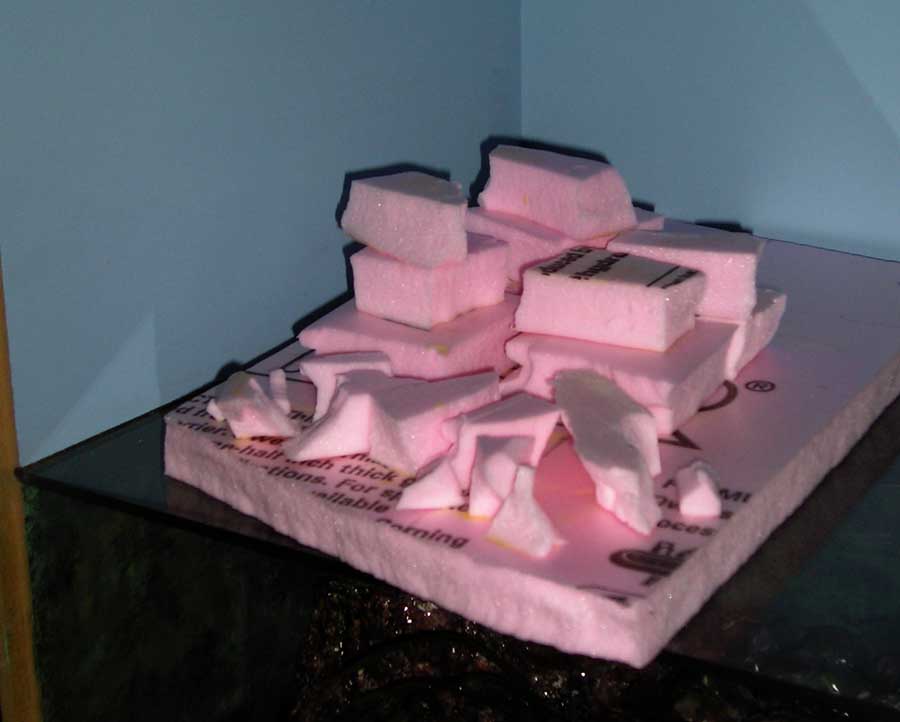
Rocks start out as expanded foam, glued to create a 3D effect and then covered in plaster of paris and allowed to dry. This reduces weight and provides greater flexibility in case creation. The downside is the work involved in the paint effect. You could of course just not include rocks in the display
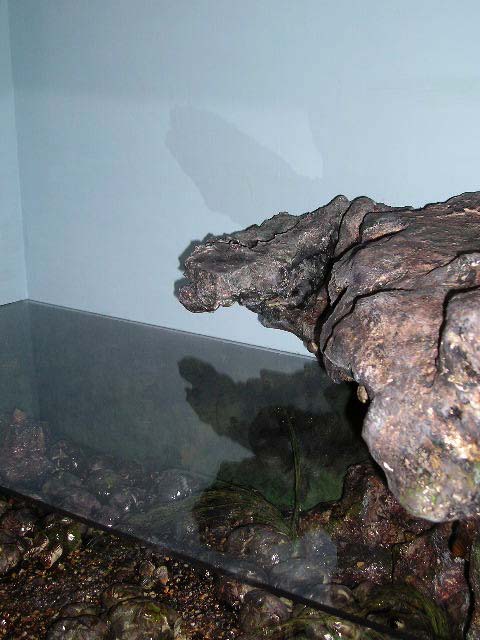
The large rock seen here has some 15-20 coats of paint to create the depth of colour and effect. The water has been created with the use of perspex, which is about a quater if an inch thick.
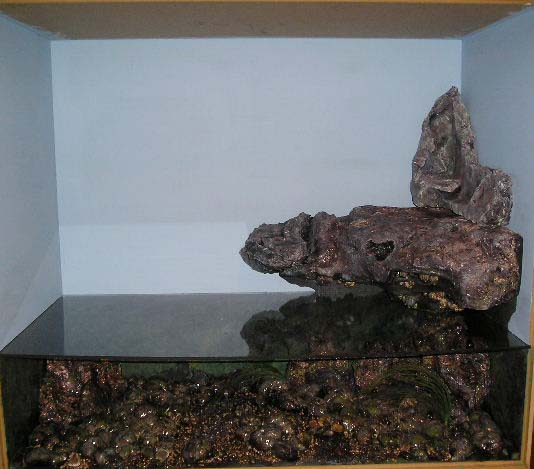
At first a small rock was created and placed upon the larger ledge, but upon review it was decied that this rock was not substaintial enought to tie the rock to the case and the case to groundwork. A larger rock was needed.
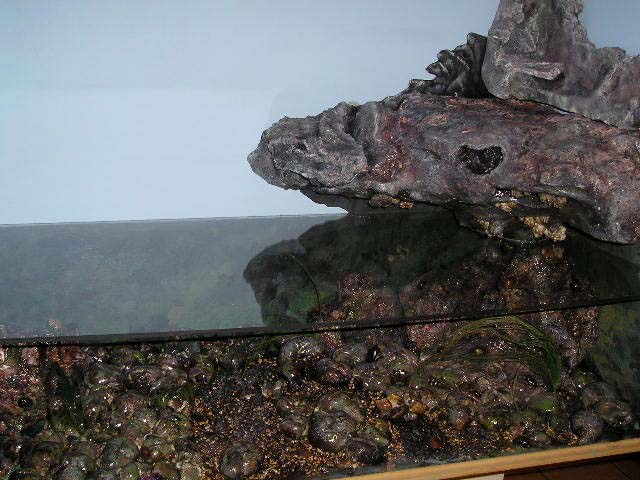
Above image from a different angle.
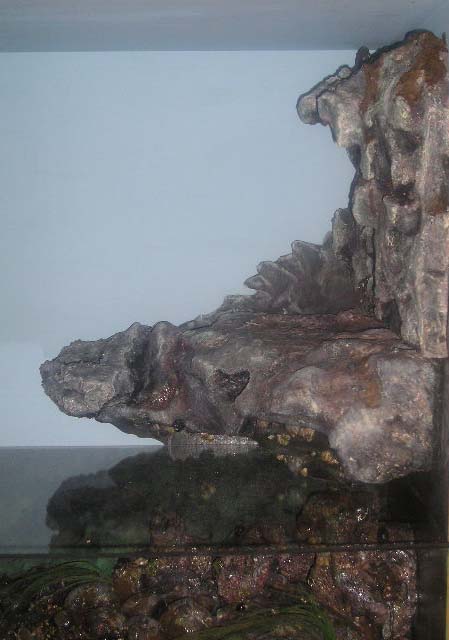
The rough dimensions of a rock was created, painted and fixed into place to ascertain whether this worked in the general scheme of the case design.
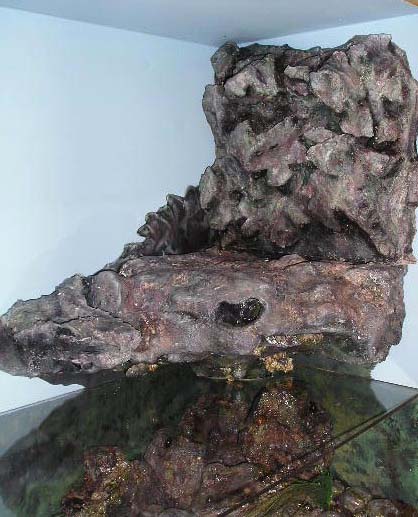
Same image as the above but showing the work required to blend the rocks together and the general composition.
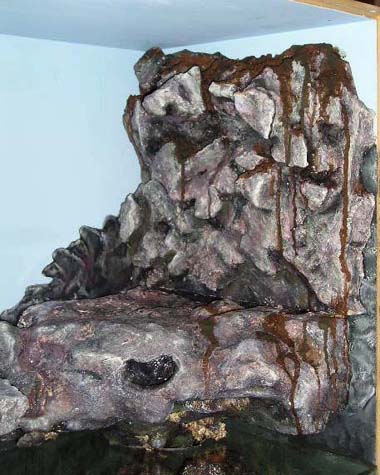
Image of the above but showing the work required to blend the rocks together and the general composition. Glue was mixed with 3 colours of earth and then allowed to flow down the rocks to tie the two rocks together as one image
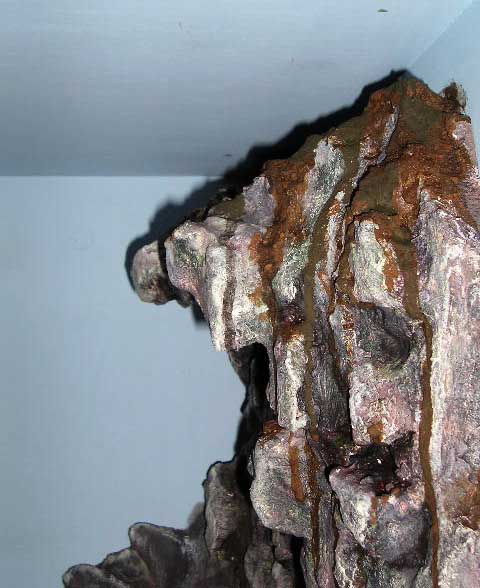
Image of the above in close up but showing the work required to blend the rocks together and the general composition. Glue was mixed with 3 colours of earth and then allowed to flow down the rocks to tie the two rocks together as one image
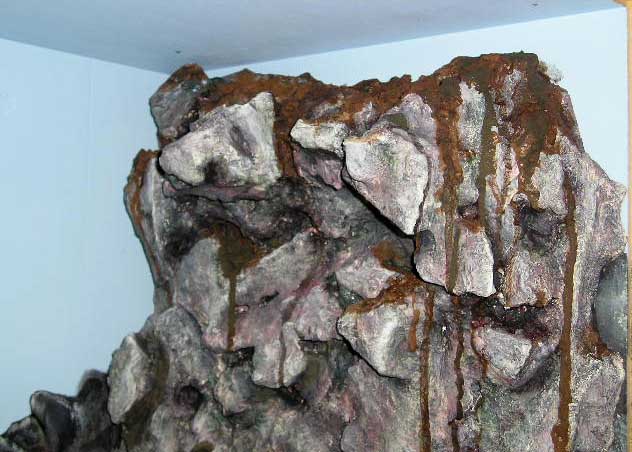
Image of the above in close up but showing the work required to blend the rocks together and the general composition. It is intended to use grasses to close out the top of the case to create the completed rock wall.
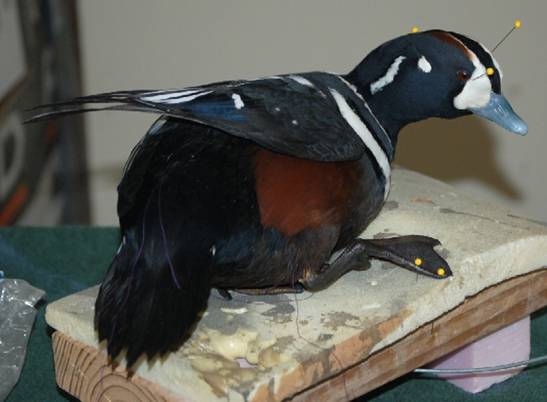
Drake Harlequin duck that shall be placed upon the rock ledge. This bird is currently in the process of drying as seen by the pins still in place. Not the stiff bog eyed mounts unfortunately created, yep you know who you are!!!. This taxidermy is undertaken by some-one who is world class, who also understands how birds move.
Harlequin duck (Histrionicus histrionicus)
The male harlequin duck (Histrionicus histrionicus) is a colorful, compact sea duck inhabiting Alaska's coasts for most of the year. The common name harlequin as well as the latin name Histrionicus (from "histrio" or stage player) come from the male plumage, said to resemble the gaily colored dress of medieval court jesters. Male harlequins are mostly a dark blue-gray, with bold accents. The face is white between the eye and dark gray bill. Black-bordered white markings include a spot over the ear, a streak on the side of the neck, a collar, and a bold sash from the shoulder to the breast. In addition, the black crown is highlighted by rust and there is a large rust patch on the flank. Females are generally a uniform grayish black, with light cheeks and spots above the eye and over the ear. Harlequin hens resemble bufflehead females that have a singular white face patch or, except for a much smaller size, female scoters. As with most sea ducks, harlequins do not mature or attain full adult plumage until they are 2 years old.
Range and distribution: There are two populations of harlequin ducks worldwide. An eastern population breeds from southwest Greenland and Iceland to Baffin Island in arctic Canada, and south into the Maritime Provinces. This population, wintering as far south as the New England states, has diminished substantially in recent years. The western harlequin duck breeds from northeast Siberia across to arctic Canada, throughout most of Alaska and British Columbia, and sparsely in the Rocky Mountain region of the U.S. as far south as California.
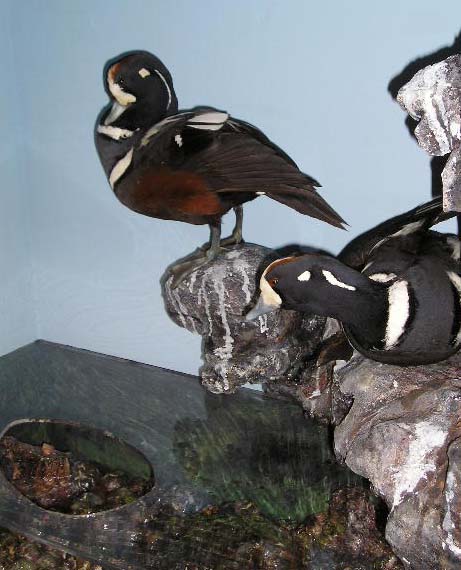
Harlequin drake in close up.
In Alaska, there are scattered breeding records for harlequin ducks from the eastern North Slope, northwest Alaska, St. Lawrence Island, Yukon-Kuskokwim region, Alaska Peninsula, Aleutian Islands, Gulf of Alaska coast, and Southeast Alaska. Because of their preference for nesting on mountain streams, they likely inhabit the upper portions of drainages throughout Interior Alaska, but observations are scarce in remote areas. Large numbers of harlequin ducks winter in the Aleutian Islands and Gulf Coast (particularly Prince William Sound), and throughout the southeastern coast south to Oregon.
Life history: The harlequin is one of the least studied ducks in North America, breeding and wintering in some of the wildest and most remote habitat in the northern hemisphere. Its choice of rugged habitats and relatively short migrations rarely bring it to major waterfowl gathering sites where ducks are most often observed and hunted. In fact, most of our knowledge of breeding biology and behavior came from studies conducted in Iceland. Recent work in the Rocky Mountains region and in Prince William Sound, as a result of the 1989 Exxon Valdez oil spill, is expanding our knowledge of this unique species.
Paired harlequins usually leave their coastal wintering grounds in May, but timing varies considerably according to diverse snow conditions across their broad breeding range. The migration can be a short "lateral" one, from sea coast to adjacent streams, for birds such as those breeding in Prince William Sound, or the trip may be lengthy and protracted for birds wintering in the Aleutians, destined for Siberia or late thawing Interior mountain streams. Harlequins are one of a few unrelated duck species throughout the world that have become "river specialists." During the breeding season, the South American torrent duck, New Zealand blue duck, African black duck, and harlequin seek rapidly flowing streams and rivers for nesting and rearing young. However, the widespread harlequin is known also to breed along glacial lakes, in tundra ponds, and perhaps rarely on offshore rocks in marine waters.
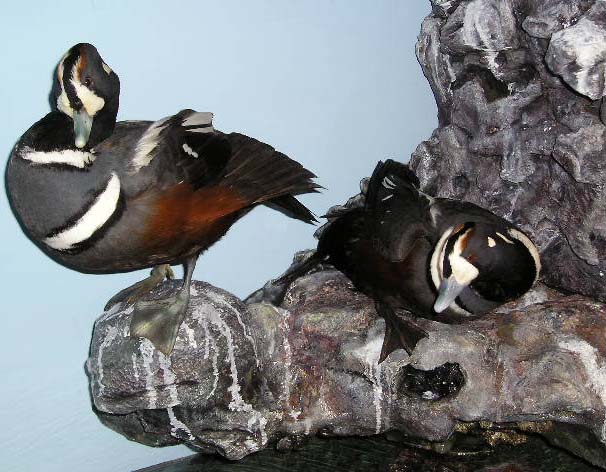
Harlequin drake in close up..
Harlequins are more often seen perched on rocks than any other sea duck. Unlike goldeneyes, buffleheads, and mergansers, which frequent calmer shorelines and customarily nap on the water, harlequin ducks in the choppy waters off rocky points and reefs expend considerable energy when they are on rough waters and cannot afford to sleep afloat. Perching on rocks saves energy reserves for staying warm and for vigorous bouts of feeding.
For most of the year, the harlequin duck's diet consists of a wide variety of intertidal invertebrates gathered from rocks and the bottom close to shore. Mollusks are a particularly important food group, especially snails, periwinkles, blue mussels, and small clams. Crustaceans, such as hermit crabs, shrimps, and amphipods also are major prey items. Unlike most marine birds, harlequins have the extraordinary ability to feed on limpets and chitons, animals that strongly attach themselves to rocks with suction cups. With strong nails at the tips of their bills, harlequins have learned to detach these tough morsels that resist the most ingenious beachcombers!
Because of their broad range and remote habitat preferences, harlequin ducks are seldom affected by human disturbances, such as industrial activity, urban bustle, or recreation. Much of their habitat remains pristine and they are numerous in Alaska during winter. However, they can be affected by degradation of water quality and encroachment of human development in breeding streams. We have also learned that harlequin ducks are particularly vulnerable to oil spills because they gather in coastal waters and depend on intertidal habitats close to shore. Harlequin ducks are not very productive, and they lead precarious lives in our mountain valleys and secluded coasts. A great deal needs to be learned about this hardy, flamboyant little sea duck to understand its needs and ensure its conservation.
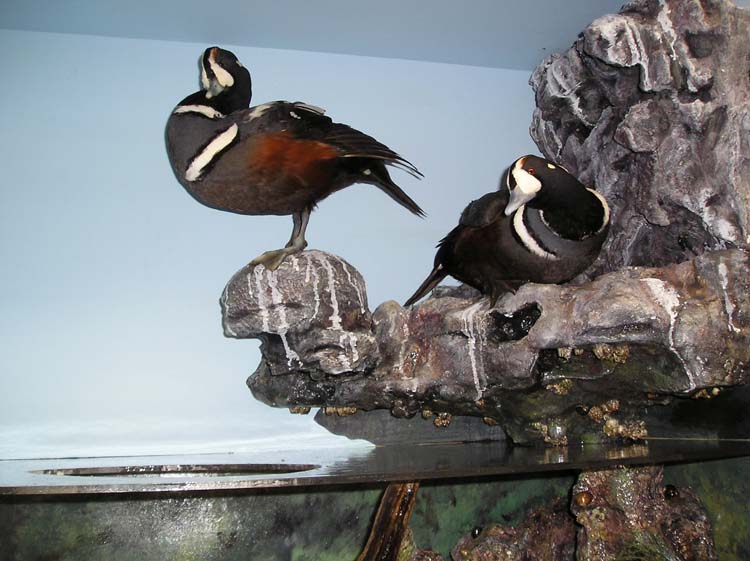
Unfinsihed case in progress. The groundwork beneath the waterline denoted by the perspex is 9 inches deep, just to give you an idea of the scale of the case.
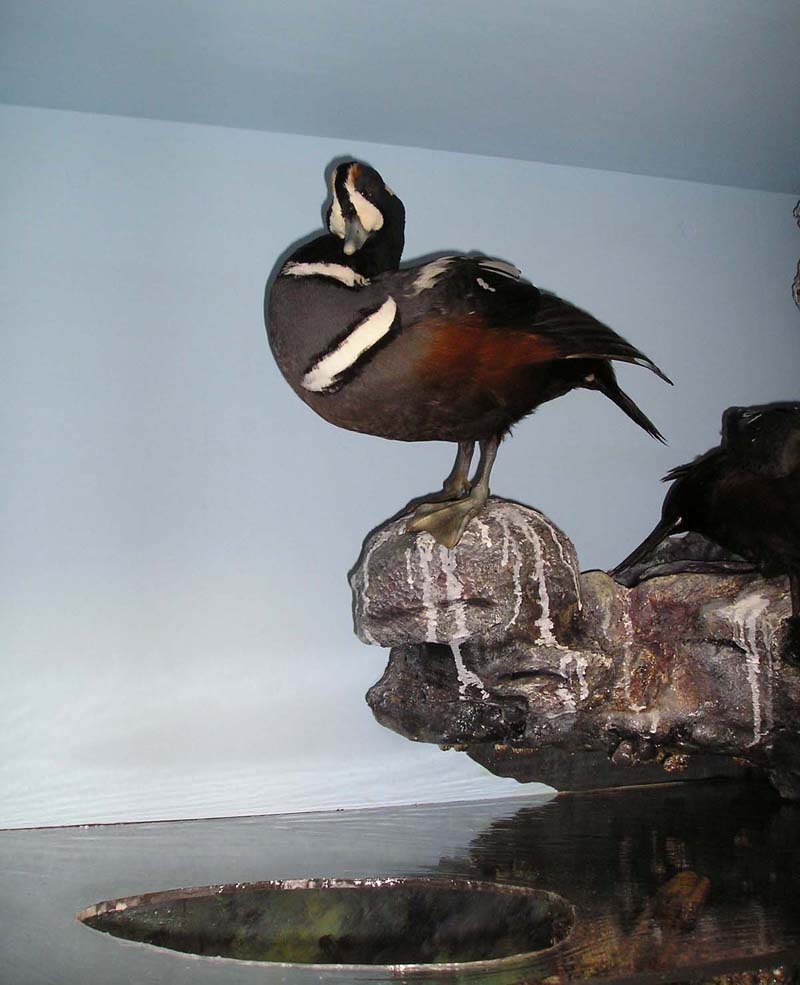
The hole cut in the perspex is to accommodate the Brent Goose in a swimming pose.
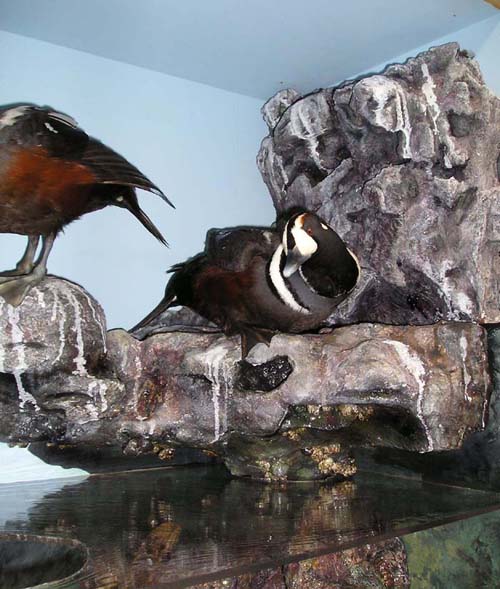
Unfinsihed case in progress.
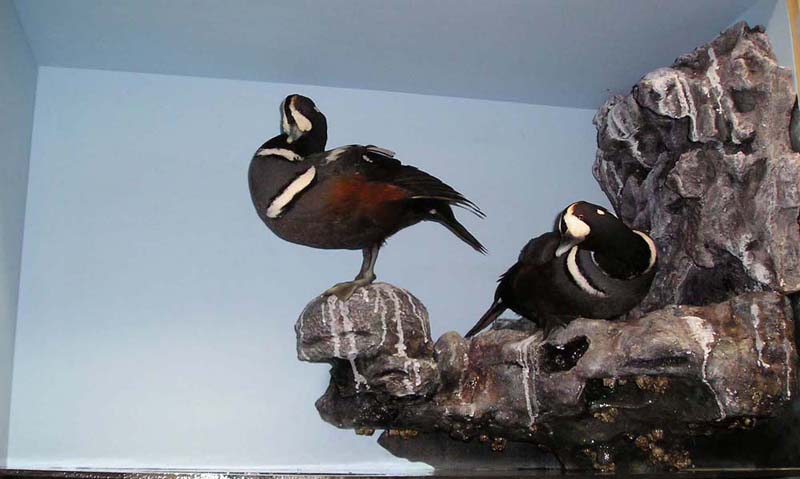
Harlequin drake in close up.
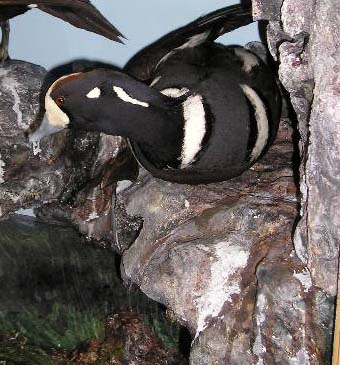
Harlequin drake in close up.
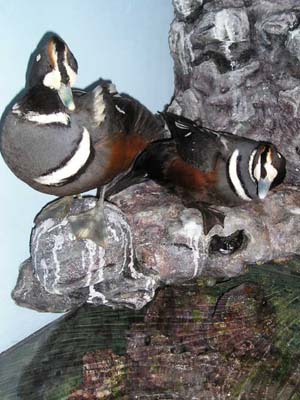
Harlequin drake in close up.
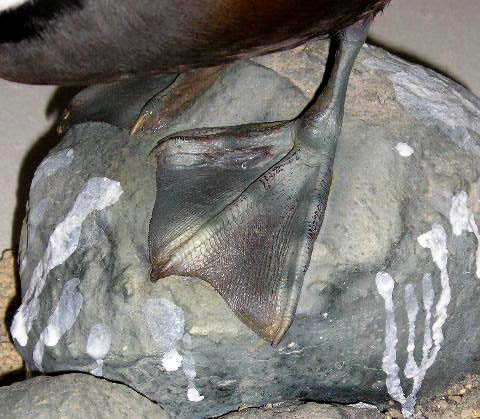
Harlequin drake feet in close up.
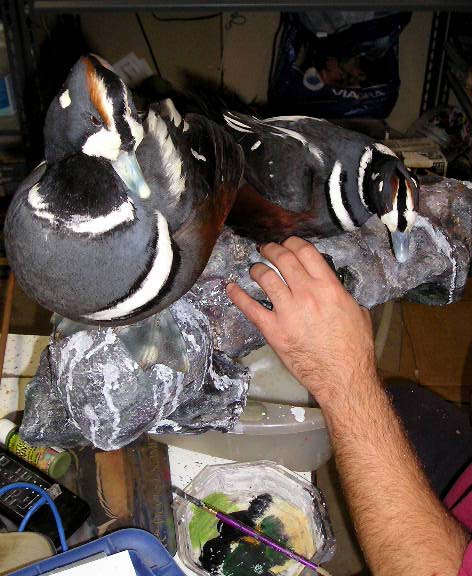
Harlequin drake in close up,showing the blending of the paint into rockwork.
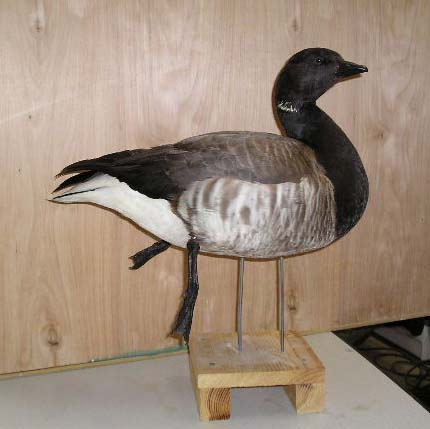
Brent Goose.
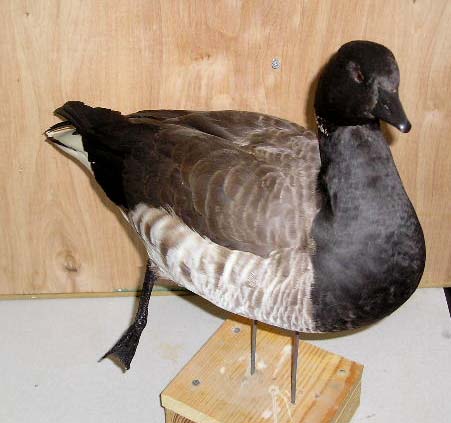
Brent Goose.
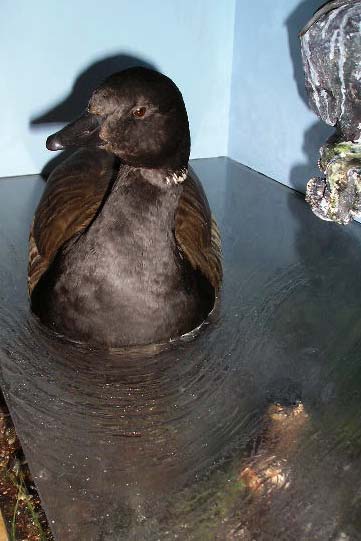
Close up of Brent goose with detail in the resin to create movement as if water.
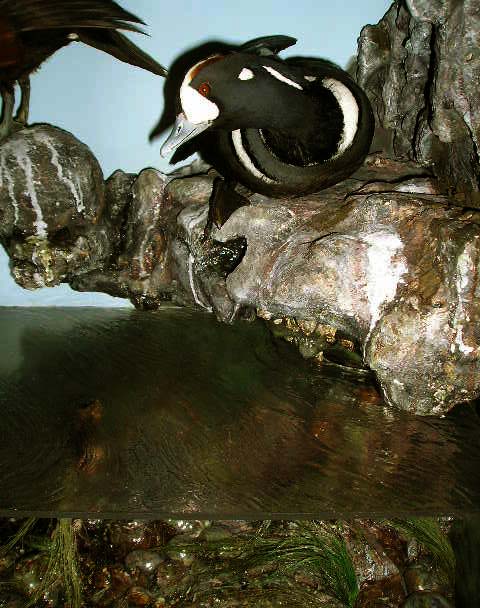
Close up of Harlequin with detail in the resin to create movement as if water.
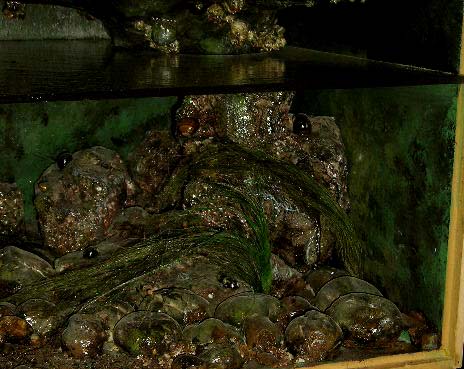
Close up of the groundwork and resin to create movement as if water.
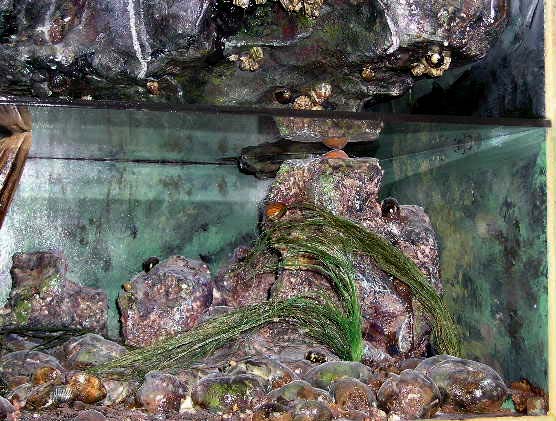
Close up of the groundwork and resin to create movement as if water.
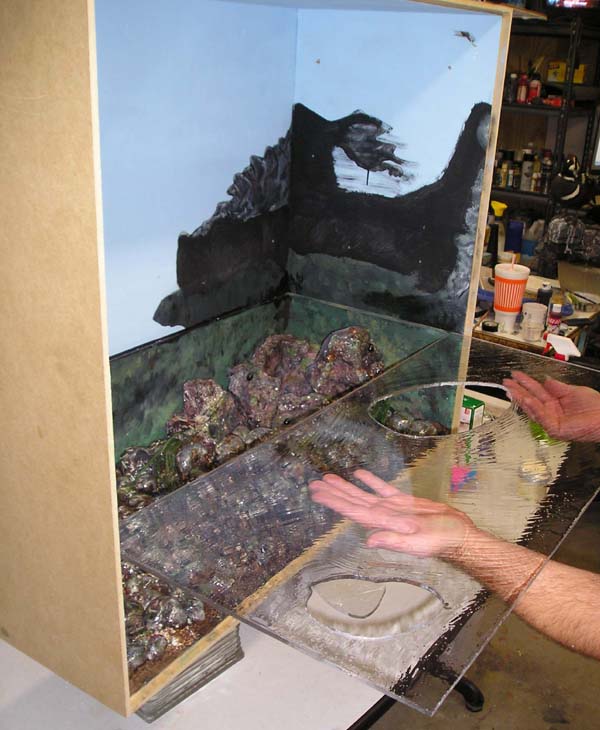
Perspex glass being fitted into the case with the holes re-cut for the rock and goose.
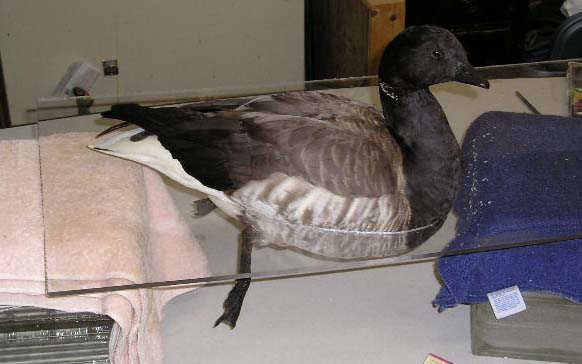
Brent Goose being fitted for the perspex glass, to guage the waterline for the bird and to get it's pose right as in life.
Brant Goose / Brent Goose (Branta bernicla)
This is a sea goose that forages largely on marine grasses, The Brant is known as the Brent Goose in Great Britain.
The Brent Goose is a small goose, about 60 cm long and with a short, stubby bill. The under-tail is pure white, and the tail black and very short (the shortest of any goose).
Brent Goose has three subspecies:
" Dark-bellied Brent Goose Branta bernicla bernicla
" Pale-bellied Brent Goose Branta bernicla hrota (sometimes also known as Light-bellied Brent Goose in Europe, and Atlantic Brant in North America)
" Black Brant Branta bernicla nigricans
Some DNA evidence suggests that these forms are genetically distinct; while a split into three separate species has been proposed, it is not widely accepted, with other evidence upholding their maintenance as a single species.
The body of the Dark-bellied form is fairly uniformly dark grey-brown all over, the flanks and belly not significantly paler than the back. The head and neck are black, with a small white patch on either side of the neck. It breeds on the Arctic coasts of central and western Siberia and winters in western Europe, with over half the population in southern England, the rest between northern Germany and northern France.
The Pale-bellied Brent Goose appears blackish-brown and light grey in colour. The body is different shades of grey-brown all over, the flanks and belly are significantly paler than the back and present a marked contrast. The head and neck are black, with a small white patch on either side of the neck. It breeds in Franz Josef Land, Svalbard, Greenland and northeastern Canada, wintering in Denmark, northeast England, Ireland and the Atlantic coast of the U.S. from Maine to Georgia.
The Black Brant appears blackish-brown and white in colour. This form is a very contrastingly black and white bird, with a uniformly dark sooty-brown back, similarly-coloured underparts (with the dark colour extending furthest back of the three forms) and a prominent white flank patch; it also has larger white neck patches, forming a near-complete collar. It breeds in northwestern Canada, Alaska and eastern Siberia, and wintering mostly on the west coast of North America from southern Alaska to California, but also some in east Asia, mainly Japan.
The Asian Black Brant populations had previous been regarded as a separate subspecies orientalis based on purported paler upperparts coloration; however, it is generally now believed not that this is not correct.
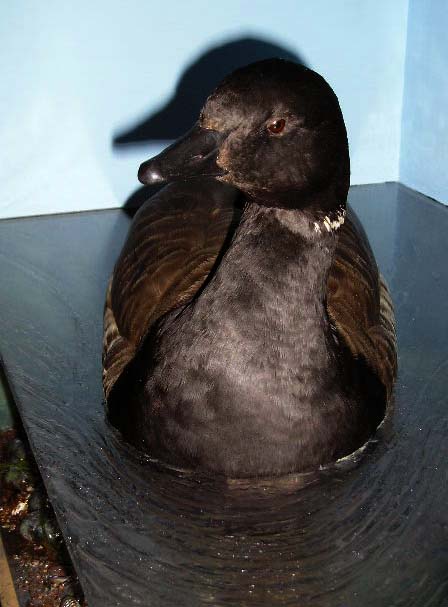
Close up of Brent goose with detail in the resin to create movement as if water.
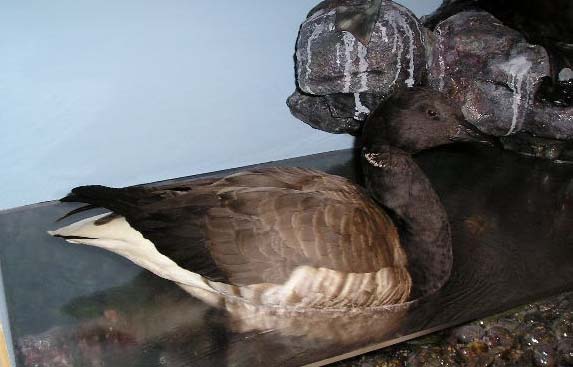
Close up of Brent goose with detail in the resin to create movement as if water.
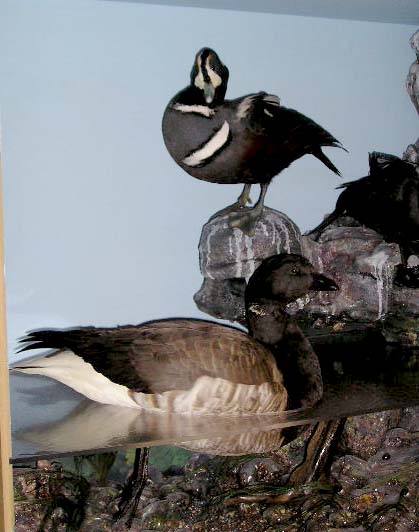
Close up of Brent goose with detail in the resin to create movement as if water.
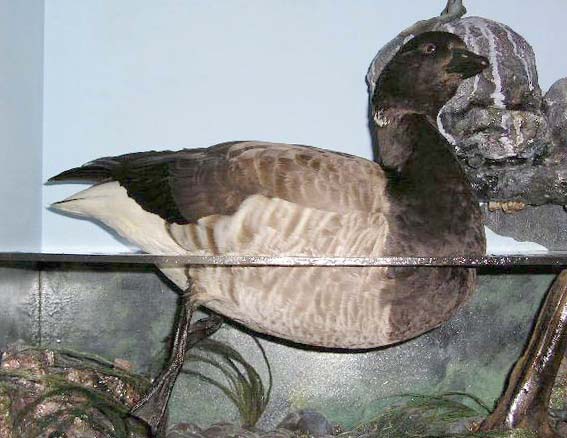
Close up of Brent goose to shown how much of the goose actually sits in the water and at what angle
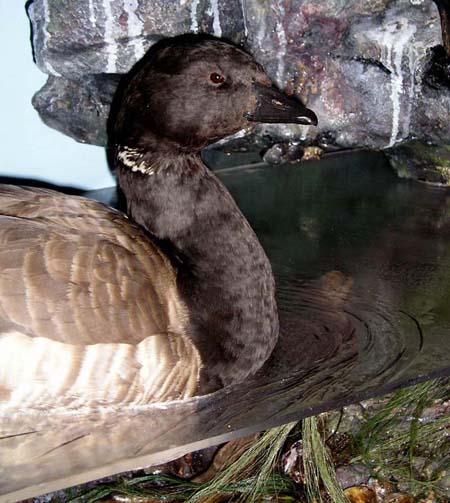
Close up of Brent goose with detail in the resin to create movement as if water.
A fourth form (known variously as Gray Brant, Intermediate Brant or Grey-bellied Brent Goose) has been proposed, although no formal subspecies description has been made as yet, for a population of birds breeding in central arctic Canada (mainly Melville Island), and wintering in the Puget Sound on the American west coast around the U.S./Canada border. These birds are intermediate in appearance between Black Brant and Pale-bellied Brent, having brown upperparts and grey underparts which give less of a contrast with the white flank patch. Given that this population exhibits mixed characters, it has also been proposed that, rather than being a separate subspecies, it is actually a result of interbreeding between these two forms.
It used to be a strictly coastal bird in winter, seldom leaving tidal estuaries, where it fed on eel-grass (Zostera marina) and a type of seaweed, sea lettuce (Ulva). In recent decades, it has started using agricultural land a short distance inland, feeding extensively on grass and winter-sown cereals. This may be behaviour learnt by following other species of geese. Food resources pressure may also be important in forcing this change, as the world population has risen over ten-fold to 400-500,000 by the mid 1980s, possibly reaching the carrying capacity of the estuaries. In the breeding season, it uses low-lying wet coastal tundra for both breeding and feeding. The nest is bowl-shaped, lined with grass and down, in an elevated location, often in a small pond.
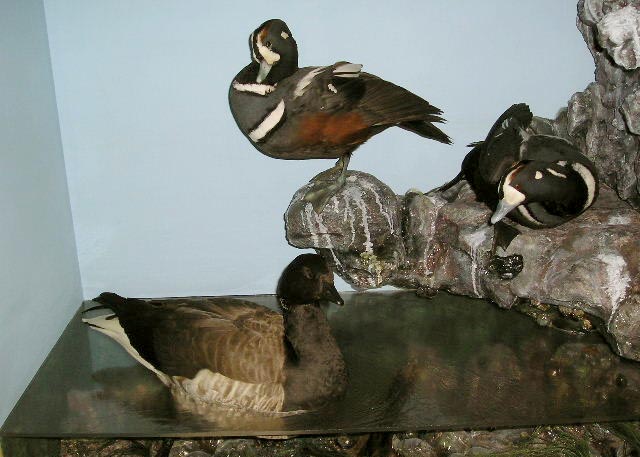
This case is nearly completed, just some beak painting and waxing and eel grass in the groundwork and the case is ready to be fumigated and glazed. Just one comment if you are considering completing cases with a water efect as above, make sure that you understand how to use resins. For example, We used two types. One that takes FOREVER to set (48 hours)and the other that sets almost straight from the mixing tub (seconds). Imagine the fun!!!!!!!!!!, given that all the birds had to be in the scene to work the resin into the scheme. You might not be able to see it but resin covers the rocks in places, beneath the large rock on the right and completely over the plexiglass. Paint effects may be used in the future.
ITEMS
WANTED. Please respond via this on-line form HERE
with a description of what you have for sale.
[HOMEPAGE]
Taxidermy Links.
Please double click on the Taxidermy link icon below.
Taxidermy
Links
|




